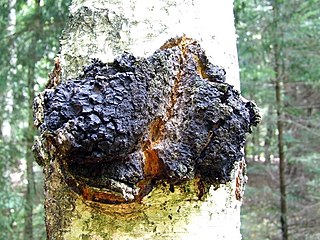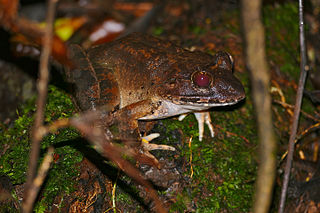
The greater bulldog bat or fisherman bat is a species of fishing bat native to Latin America. The bat uses echolocation to detect water ripples made by the fish upon which it preys, then uses the pouch between its legs to scoop the fish up and its sharp claws to catch and cling to it. It is not to be confused with the lesser bulldog bat, which, though belonging to the same genus, merely catches water insects, such as water striders and water beetles.

The Hymenochaetales are an order of fungi in the class Agaricomycetes. The order in its current sense is based on molecular research and not on any unifying morphological characteristics. According to one 2008 estimate, the Hymenochaetales contain around 600 species worldwide, mostly corticioid fungi and poroid fungi, but also including several clavarioid fungi and agarics. Species of economic importance include wood decay fungi in the genera Phellinus and Inonotus sensu lato, some of which may cause losses in forestry. Therapeutic properties are claimed for Inonotus obliquus ("chaga") and Phellinus linteus, both of which are now commercially marketed.

Leporinus is a genus of fish in the family Anostomidae native to South America. The fossil species Leporinus scalabrinii, known from the late Miocene of Entre Ríos in Argentina, has only recently been added to this genus after being misidentified as a species of primate under the name Arrhinolemur scalabrinii for over 100 years.

Betulin is an abundant, naturally occurring triterpene. It is commonly isolated from the bark of birch trees. It forms up to 30% of the dry weight of silver birch bark. It is also found in birch sap. Inonotus obliquus contains betulin.

Inonotus obliquus, commonly called chaga, is a fungus in the family Hymenochaetaceae. It is parasitic on birch and other trees. The sterile conk is irregularly formed and resembles burnt charcoal. It is not the fruiting body of the fungus, but a sclerotium or mass of mycelium, mostly black because of a great amount of melanin. Some people consider chaga medicinal.

Inonotus hispidus, commonly known as shaggy bracket, is a fungus and a plant pathogen. This fungus has been used in eastern Asia as a popular remedy for many illnesses like cancer, diabetes, and other stomach ailments. In modern pharmacology, it has aided in lowering blood glucose levels, showing anti-tumor responses and improving overall health in mice.

The giant river frog is a species of frog in the family Dicroglossidae. It is endemic to Borneo, and found in Brunei, Kalimantan (Indonesia), and Sabah and Sarawak (Malaysia).

Meshimakobu and sanghuang / sanghwang, also known as mesima (English) or black hoof mushroom, is a mushroom in East Asia.

Inonotus is a genus of fungi in the family Hymenochaetaceae. The genus, described by Petter Karsten in 1879, is estimated to contain about 80 species sensu lato and 30 species sensu stricto.

Inonotus dryadeus, commonly known as oak bracket, warted oak polypore, weeping polypore or weeping conk, is an inedible species of fungus belonging to the genus Inonotus, which consists of bracket fungi with fibrous flesh. Most often found growing at the base of oak trees, it causes white rot and decay of the trunks. It secretes an amber liquid which weeps from tubes in its upper surface.

Leporinus fasciatus, commonly known as the banded leporinus or the black-banded leporinus, is a species of characin in the family Anostomidae. L. fasciatus is native to the Amazon Basin in South America, but has been introduced into the US states of Florida and Hawaii. It has not been observed from Hawaii as of 2005; the species is thought to have been extirpated in the region.
Wolfgang Klausewitz was a German zoologist, ichthyologist, marine biologist and biohistorian.
Tropicoporus tropicalis is a mushroom of the family Hymenochaetaceae. Tropicoporus tropicalis is a wood-decaying basidiomycetes that rarely causes disease in animals and human, and is commonly found in humid climate such as Brazil. In its natural environment, the fungus is associated with white rot woody angiosperms, and has its annual fruiting body on tree trunks and branches. Tropicoporus tropicalis has two kinds of hyphae, generative and skeletal, that lack clamp connections.
Inonotus chrysomarginatus is a species of fungus in the family Hymenochaetaceae. It is distinguished by having an annual to perennial growth habit, pileate basidiocarps, setal hyphae and hooked hymenial setae, and subglobose, yellowish, thick-walled cyanophilous basidiospores.

Leporinus muyscorum is a species of freshwater fish in the genus Leporinus. It is endemic to Colombia, where it occurs in the Magdalena River Basin and Atrato River. The species was first described by Franz Steindachner in 1900.

Leporinus enyae is a species of Leporinus fish discovered 2017 in the Orinoco River drainage area. It is named after the Irish singer Enya, whose major music hit "Orinoco Flow" deals with the Orinoco River, among others.
Leporinus octofasciatus is a species of anostomid fish. It is found in the northern Cubatão River in Santa Catarina and the upper Paraná River basin in Brazil.
Leporinus paranensis is a species of anostomid fish. It is found in the Paraná River basin in South America.











